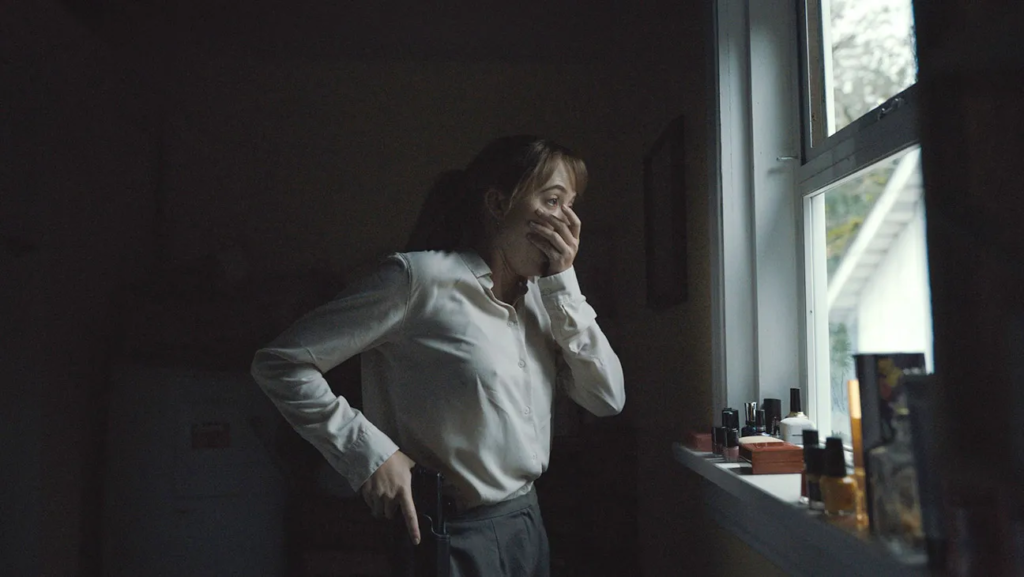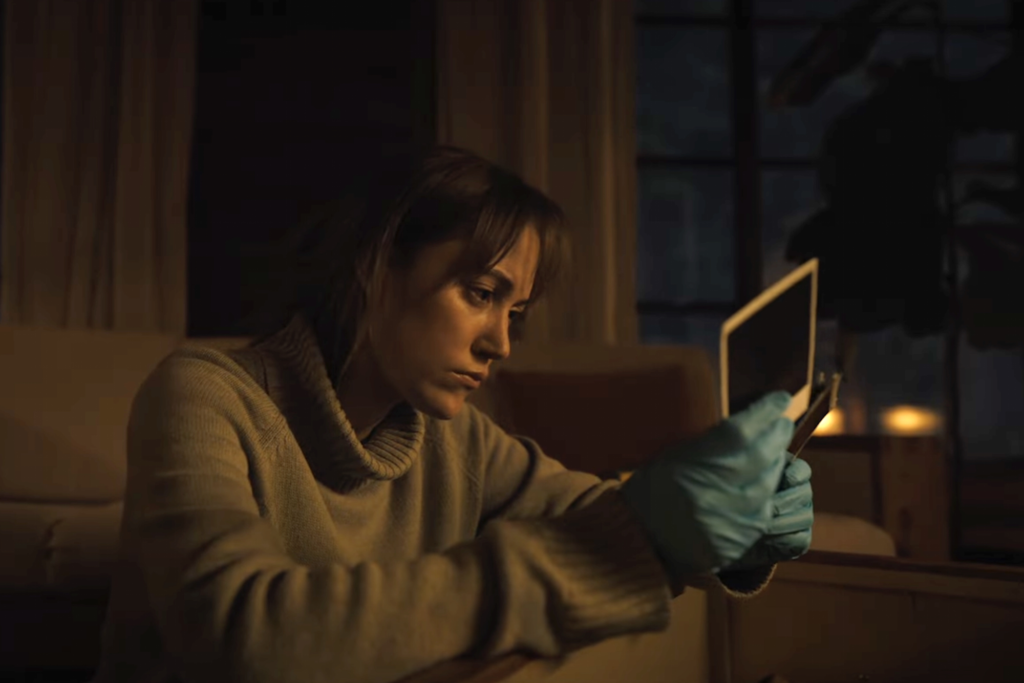Director: Osgood Perkins
Writer: Osgood Perkins
Stars: Maika Monroe, Nicolas Cage, Blair Underwood, Alicia Witt
Synopsis: When FBI Agent Lee Harker is assigned to an unsolved serial killer case that takes an unexpected turn, revealing evidence of the occult, Harker discovers a personal connection to the killer and must stop him before he strikes again.
Lee Harker (Maika Monroe) struggles with eye contact. Fresh out of the academy, the green, stoic, “semi psychic” FBI prodigy tends to glue her peepers to the ground as opposed to resting them on her fellow agents, let alone the killers she spends her long days and nights hunting. The only time she seems capable of staring straight ahead is when she’s peering down the barrel of a gun, aiming it towards an unarmed suspect whose propensity for unimaginable violence is more dangerous than they are in the moment. She’s troubled and muted, but brilliant, able to determine that a vicious murderer is hiding in house no. 3525 based on nothing but a feeling she describes as a tap on her shoulder telling her to look there.

If only solving the crimes of a serial killer known only to the FBI as “Longlegs” were so simple. Over three decades, he has murdered close to 40 people in the Pacific Northwest, somehow managing to make each crime look like a murder-suicide in which a church-going father goes on a sudden rampage, viciously killing his wife and children before turning the gun on himself. This “Longlegs” leaves behind but one thing at each crime scene, a birthday card with a coded message delicately jotted out above his signature. And by one thing, I mean one thing: Each crime scene is barren of forensic evidence pointing toward the presence of an outsider at any time while the murders took place. Apart from general demographic similarities, these cards are the sole thing connecting each crime scene to the next. How he’s delivering them and disappearing without a trace is one mystery; how he’s convincing these fathers to kill, given that he isn’t physically present for the deaths, is another.
So goes the general set-up for Osgood Perkins’ Longlegs, a nightmarish flick about an elusive, menacing madman with a reputation that feels in lockstep with the film’s own renown, one that has long-preceded its release, let alone the first audiences who set eyes on it. Thanks almost entirely to a brilliant, cagey marketing campaign, Neon’s latest horror offering became number one with a bullet on “most anticipated” lists aplenty, with prospective viewers itching to know what the face of the creepy, high-pitched voice that accompanied its increasingly reticent trailers and promotional voicemail recordings looked like, despite knowing full-well that Nicolas Cage was set to appear in the titular role. Adding fuel to the fire, there is thebirthdaymurders.net, the film’s unofficial website that documents the history of this “Satan-worshiping psycho’s” crimes with a warning for visitors to “buckle up and hold on tight.” Finally, came the lofty praise from those who saw the film in advanced screenings, calling it the best serial killer film since masterpieces including The Silence of the Lambs, Se7en, and Zodiac. The opportunity to temper expectations was rendered hopeless; aloft they were, aloft they would stay.

These advertising stunts, if you will, are almost impossible to avoid when talking about Longlegs itself because of how well done they all were, and how disappointing the film initially felt in comparison to the work its studio had done to prop it up as this generation’s answer to a horrifying hypothetical Make-A-Wish in which Jeffrey Dahmer comes to your home for dinner. But in retrospect, that Longlegs fails to live up to its hype doesn’t make it a lesser film, but perhaps a more interesting one to discuss. A film is to its marketing campaign as a team is to its trash talk; you can make threats all you want, but what matters is whether or not they can deliver. Neon and, less so, Perkins pledged to provide revelations in horror cinema. But, as Lee corrects a fellow agent when referencing the New Testament chapter of the same name, it’s actually just “Revelation.” Not many, just one. That still counts for something, if not the exact feat that was promised.
Split into three chapters – “His Letters,” “All Your Little Things,” and “Birthday Girls” – Perkins’ fourth directorial effort unfolds like a police procedural in that we begin with a conundrum, follow it up with a slew of questions, and ultimately arrive at a solution, a frustrating structure for a movie that otherwise operates as a perfect enigma in and of itself. It’s clear from the moment we meet Lee that she’s different, a mind that sees cases through a different lens than her counterparts, making her methods and deductions complex in execution and explanation alike. It’s also evident that she has some sort of connection to Longlegs in relation to her complicated upbringing – a freakish, frantic Alicia Witt turns in the film’s best performance as Lee’s twisted mother – and it’s hinted at for much of the film’s runtime, until its startling conclusion rips the Band-Aid off with the brute force of an axe to the collarbone.
Because Perkins is adeptly unwilling to reveal too much of his hand until the perfect moment presents itself, he keeps Longlegs at an arm’s length, not just from Lee, but from the audience. Rest assured, you do get to see Cage in all his pale-faced, spine-chilling glory, but his presence comes in fits and starts; he only ever comes face-to-face with Lee once – fittingly, it’s in the film’s best scene – leaving a certain level of ambiguity to the horror he represents, much like the murderous maze he lays out for the FBI with every passing kill. Lee and her boss, Agent Carter (Blair Underwood), steadily uncover his clues, all of which he intentionally leads them to, and with every answer comes another puzzle. Longlegs (and Longlegs) loves its friendly game of cat-and-mouse, but who’s who in this particular duel lies in your interpretation of which party is in control.

Whether or not you’re patient enough to mull that over could spell your fate in regards to appreciating Longlegs for what it is, or clamoring for it to be what you wanted it to be. Frankly, that internal battle could apply to any of its many tricks and scares, or lack thereof. Which is not to say it isn’t scary, just that it doesn’t quite crawl under your skin and chew on your tendons the way many have implied it will. But perhaps that lies in the eye and stomach of the beholder just as much as the importance of the riddles Longlegs leaves in those terrifying birthday cards depends on your ability to decipher their meaning, not to mention whether you believe they have a meaning at all.
Sound designer Eugenio Battaglia and composer Zilgi supply a haunting, methodical atmosphere to the film, taking scenes that feel as though they could be bright in an alternate world and clouding them with an incomparable darkness, the sort that not even a night light could alleviate. Visually, everything feels a bit distant, with Andrés Arochi’s camera capturing an abundance of wide shots that provide viewers with a setting’s full scope. The distance feels comforting at times, until suddenly, you’re wrenched from the hallway to the heart of the living room, a brutal discovery suddenly lying inches from our gaze. While it all feels a bit literal, there is narrative and thematic depth throughout the film these shots and sounds surround, two attributes that allow for a bit of breathing room in a work that is hell-bent on being claustrophobic, if not suffocating.
Such an achievement in technicality and tension deserves a far better ending than what Perkins provides in the film’s final act, an exposition dump that threatens to undo everything that made Longlegs so cryptic from the start. When Longlegs himself refers to “the man downstairs” and/or “a friend of a friend of a friend,” it’s not all that difficult to deduce who (or what) he’s referring to, making his perplexing cryptograms feel like red herrings rather than pivotal devices in his devious game. But not every mysterious fright needs to be all that intricate in order to be considered a success, even if it’s a milder one than advertised. Longlegs is, indeed, a tale in which terror is ever-present. It just doesn’t manage to lurk in the shadows as long nor as subtly as we convinced ourselves it would.





